If you’ve either flown into/out of Venice, or driven into/out of Venice, you already know that the mainland (a/k/a “the rest of the world”) involves a surprising amount of farmland. Or fields, anyway. It’s not Kansas, true, but there is a noticeable amount of cultivation going on.
Back in Venice, we have a first-rate country option which doesn’t involve going over the bridge. Or getting in a car. We go there in a small boat, rowing.
It’s the island of Sant’ Erasmo — the largest island in the lagoon (3.26 km/s, or 1.25 square miles), though that isn’t what makes it worth knowing about.
It’s farms. Or better, market gardens, though some of them are larger than what we usually think of as gardens, unless the garden were to be Longwood or Stourhead or the Villa d’Este.
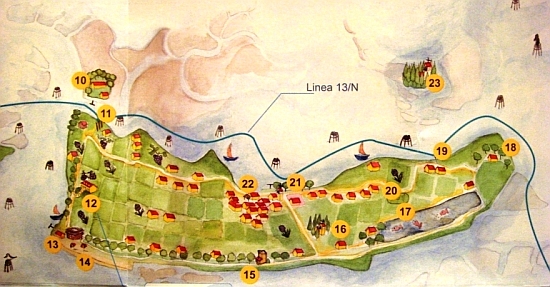
I have mentioned Sant’ Erasmo from time to time — odd, perhaps, when you consider that it isn’t on the way to anywhere, and that if you’re not interested in vegetables or biking or mosquitoes, there isn’t much reason to come all the way over here.
Ninety-eight percent (I made that up) of the island consists of comfortably large plots of grapevines, artichokes, peas, asparagus, and whatever else is likely to grow in its appointed season.
The words “Sant’ Erasmo” scribbled on signs stuck among the produce at the Rialto Market always means something special (fresh, local, really good). I eventually discovered that (A) the label isn’t always accurate (fancy way of saying “untrue”) and (B) that I can get them at the source itself. This has made me insufferably demanding now. That may seem a little silly when discussing mere vegetation, but I can taste the difference, and I can really taste how much less expensive they are than at the vendor’s stall in the Big City.
Shopping for vegetables is also a great excuse for an excellent row across part of the lagoon.
We have two sources, so far.
Our first option is a modest but flourishing commercial operation called “Sapori di Sant’ Erasmo” (Flavors of Sant’ Erasmo — not a bad name unless you’ve come here often enough to associate the island with the flavor of mosquitoes). It belongs to Carlo and Claudio Finotello and there is virtually always someone there, ready to sell you some of their produce. If you’re lucky, also a bottle or two of their wine. I don’t drink, but I’m very happy that there’s a place where you can get some real local Raboso.
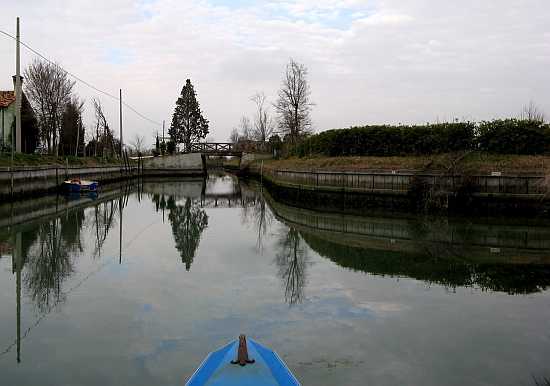

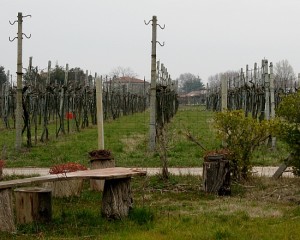
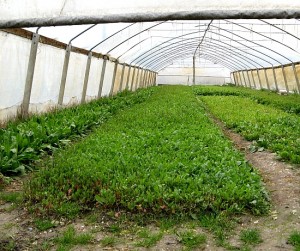

The second option is the modest but variegated plot belonging to a man — actually, his aged parents — two steps from where we pull the boat onto the beach near a rumpsprung bar/restaurant called Da Tedeschi. He’s been known to buy artichokes from him that he’s just cut off the stalk for us. Tomatoes, lettuce, cabbage, cauliflower, eggplant. Only problem is, he isn’t always there. And/or there’s nothing growing that’s ready or that we even slightly want.
The other morning we went ashore near the second option: The plot near the beach, where we found the man (I still don’t know his name) and his brother (ditto) tilling the soil by their parents’ house. Parents nowhere in sight. This is what kids are for.
The older man got to talking with us as we watched his brother working the soil with a broad hoe, preparing it to be sown with tiny little Ukrainian onions all ready to take root.
He imparted the following fragments of information: He retired three years ago after 45 years as a master glassmaker on Murano, work which he started when he was 12 because back then, not so many people went on to study and besides, he didn’t like studying all that much.
That there used to be a big acacia tree right over there (pointing toward the beach) that put out pink blossoms in the spring. They would pick the blossoms, then bread them and deep-fry them, the way people do more commonly now with zucchini blossoms. His expression as he remembered this delicacy told me that it was worth experiencing and that he misses it. I’ve never tried fried acacia flowers, but after having seen his face, I resent the fact that I never had the chance to.
Artichokes: Everyone, even I, knows that Sant’ Erasmo is famous for its “violet” version, and that the salty soil is one factor in their flavor. What I didn’t know is that one plant will put out roots to create four or five other plants, and that a normal plant will produce up to 21 artichokes.
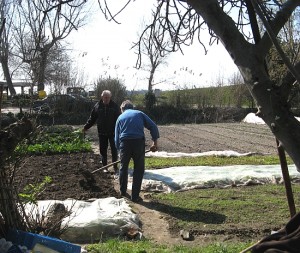

I have now also learned that they can’t be grown in hothouses. You’ll be glad to know I can’t tell you why (we’d be here all day, at this rate), but I believe him when he says that under the big top the plants grow unnaturally tall, produce fewer artichokes than normal, and that the artichokes they do produce are kind of — he made a soggy, wilting sort of grimace — what they would call “fiapo” (FYA-poh). Fiapo is what happens to your grilled-cheese sandwich when you have to leave it to go answer the phone. People can also be fiapo, usually in August.
Unfortunately, artichokes from Sant’ Erasmo have one thing in common with pieces of the True Cross: There are too many of them to be real. In fact, artichokes from Livorno, which are trucked over to Venetian markets, come in so much earlier than the Sant’ Erasmo product that labeling them as local eventually caused serious protest. Telling that little fib will get you a fine, if you’re caught.
Then there was the year of the Big Freeze: His friend had 1,300 peach trees on Sant’ Erasmo. They were all destroyed.
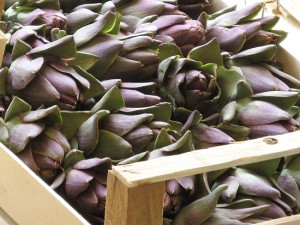
But then there was this: The year of the Big Acqua Alta (Nov. 4, 1966, as all the world knows), was the only time Sant’ Erasmo has gone underwater. In fact, he said, the island was like a semi-submerged barena. Nobody had ever seen this happen, but there were two results.
One: All the crops were totally ruined by the salt water soaking. No surprise there.
Two: The following year, they had a mythically great harvest of just about everything. Whatever the Adriatic had taken away with the flood, it more than gave back the next year by means of whatever elements it had brought in. I don’t believe it was just salt, because salting the fields has been a time-dishonored way of destroying future crops for several whiles.
Lino supports my theory that the tide brought something that the salt couldn’t vanquish, because he said that when you raise a sunken boat out of the lagoon, it’s covered with the finest conceivable layer of some kind of material. I’m imagining melted earth that’s been clarified, like butter.
Anyway, that’s just my theory — obviously the fields knew what was happening, so let’s move on. What we do know is that the next summer, the memory of the lost winter harvest had been transformed into a glowing realization that life is, indeed, good.
At least on Sant’ Erasmo.
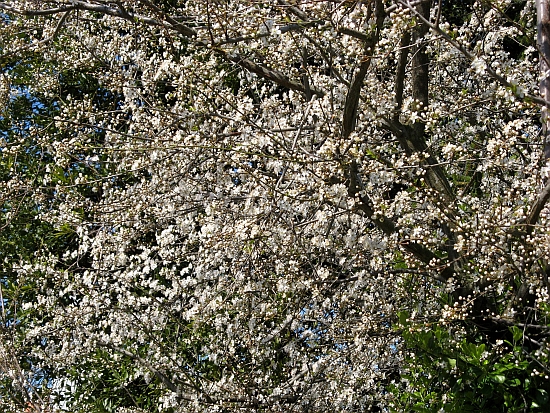

9 Comments
YES! What a wonderful island it is! …and don’t forget the honey-man round about N°15, and, and, and (well, we wouldn’t want to give away too many secrets, would we?) In the summer you can display your local loyalties (or dis-) by choosing which Pioggia or Ape you choose to shop from, near the beach. We call the Croatian lady married to a Sant’Erasmino, “La Donna dell’Orto”, and as you queue, you can pick up any number of recipe ideas from the other Italian shoppers-cum-boat-people waiting at her truck. We once caught Michaela Scibilia herself filling a shopping bag…
Well done, Erla, as usual!
Sant’ Erasmo reminds me of Lopez in the San Juans where some of my family is from: the tourists mostly go out to the other islands but then there’s large and laid back Lopez, full of farmland with a vineyard, fishing lake, golden crops, and even some highland cattle for good measure.
Sounds wonderful. I think we should all go there immediately!
Heartfelt thanks for your Venice blog, Erla, from a Venice-homesick Swiss who tries to get a few weeks’ worth Venice feeling every year (alas, not always successfully). I only discovered Sant Erasmo recently and ‘by mistake’ (wrong linea) and felt as if landed in paradise. It was a beautiful, warm November day (we never come in the summer) and we strolled slowly inland on the small road from the fermata by the church, accompanied by a little dog. I can’t tell you how much at peace I felt at this moment, on this island so close to the rest of the world and at the same time so utterly distant from all the crazy hubbub. And when we came upon the Ristorante, where the old lady served us a wonderful coffee with homemade torta although the restaurant was actually closed, our happiness was perfect. We ended up with a lively chiaccherata with the landlord and lady about la famiglia and everyday life on Sant Erasmo and I never wanted to leave again. I felt this might be the ideal place to live – within earshot of the most beautiful town of the world and in the country at the same time! – Hope to get to Venice sometime this year, in the meantime will fuel up on your blog! – kind regards to you and auguri a Venexia bea! Danielle
I loved this line, especially:
” I’m imagining melted earth that’s been clarified, like butter.”
Thank you for the wonderful account! Waiting for the Spring sun to melt the snow and thaw the ground, your Sant’Erasmo adventure made me want to go there just to dig my hands in the soil!
I’m really happy that my little scribble made you feel so good. I myself (so far) have never experienced that digging-hands-in-the-soil urge, but I’m always ready to benefit from somebody else’s!
“Fiapo”.
So funny.
Thanks for the fun read, Erla.
What a great post.
Thanks Erla,
After reading this Verena, a garden person, said that maybe she would like to return, although not exactly to Venice. San’ Erasmo sounds pretty good to me too.
John